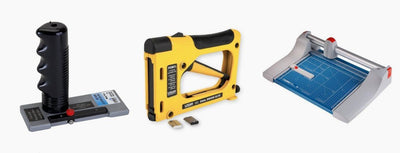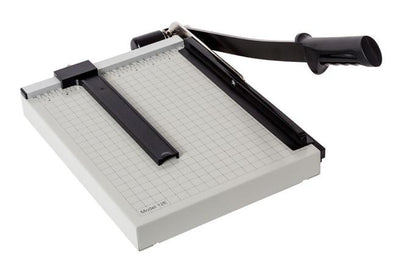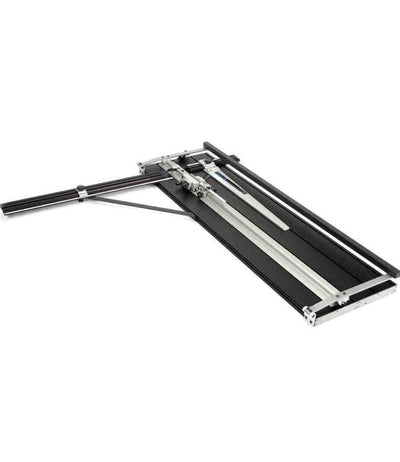Right after creating and printing your files, a crucial final step follows: paper finishing. Depending on what type of files you’re working with and what they’re for, different finishing techniques could be necessary: laminating, perforating, creasing, folding, cutting, or any other process to prep the material for use.
Cutting is the most commonly used steps to finalize files and printouts. If you’ve ever bought postcards or gone to a photo-printing house to get a tangible version of your treasured memories, you’d understand that having clean and precise cuts is definitely a must.

In a school and office set-up, messy or crooked cuts can affect our perception of someone’s or a company’s degree of professionalism. Thankfully, there are several tools we can use to make burr-free cuts without much hassle.
In this article, we’ll talk about some of the staple equipment of offices, schools, and businesses: paper cutters and trimmers. We’ll look into their different types, which should guide you in choosing the best paper trimmer or cutter for you. We’ll also go through their best features, particularly those that boost their efficiency and user safety.
Historical Overview
Historical records agree that paper cutters have been around since the late 1830s. The initial design, made by an inventor named Thirault, had a single core component: a fixed blade placed on a flat surface.
However, paper cutters that bear semblances of the modern ones we have today were only developed and patented in 1844 and 1852 by French inventor Guillaume Massiquot. Massiquot’s design was modeled after the structure of guillotines--tools that were originally designed for execution purposes during the French revolution.
Since Massiquot’s design came out, various improvements were done over the years, especially by inventors from Germany, England, and the USA. Also, following the development of different paper designs and formats--including special papers, cardboards, large-format papers, and the like--designers and manufacturers created cutters and trimmers than can accommodate different paper types and sizes with ease.
Paper Cutters & Trimmers: What’s the Difference?
The terms paper cutter are paper trimmer are often used interchangeably—and understandably so. Cutting and trimming are essentially similar functions, but the ultimate distinguishing factor is how much a tool can cut in a single go.
Paper cutters are generally used to cut multiple sheets or stacks of paper. Paper trimmers, on the other hand, are designed for a single to a few sheets of materials. Of course, paper cutters can also cut single sheets, but they are the most useful and cost-effective for organizations that need high-volume and heavy-duty cutting.
How to Choose a Paper Cutter or Trimmer?
Similar to choosing any piece of equipment, one’s criteria in choosing a paper cutter or trimmer must be based on defined needs and preferences. What an organization needs should depend on what types of files they need to cut or trim, how much in terms of sheets or stacks, how often, how efficient the cutting needs to be, and the like.
It’s also important to gain an awareness of the options that are available. With such an awareness, one can consider different features and factors and weigh them against their preferences in terms of design, price, ergonomics, and other important concerns.
The three general types of paper cutters and trimmers are the following: paper guillotines, stack cutters, and rolling trimmers. What does each of them mean and what features do they include? Keep reading to find out.
Paper Guillotines
Paper guillotines are the most commonly used type of paper cutters. They’re also usually the cheapest and easiest to find, making them a great option for personal use as well as for offices and schools. They’re highly suitable for cutting single to several sheets of ordinary bond, photo papers, flyers, brochures, booklets, and other materials that could fit the length of the cutter’s blades.
These types of cutters are available in various lengths, but they typically don’t exceed the size of standard A4 papers. There are bigger models that can cut A3 and bigger papers, but they are reasonably more expensive.
How They Work and How to Use One
As their name suggests, paper guillotines are made based on the design of guillotines. Thankfully, they are not as big or hazardous, so they’re perfectly safe to use as long as users take some safety precautions.
Paper guillotines feature two blades: one that moves with the cutter’s handle and a stationary one on the base. To cut through a paper, you simply have to:
✔ place the material/s on the guillotine’s board,
✔ position and align it/them according to the required or desired measurements,
✔ secure the material/s using a built-in clamp (if available), then
✔ move the handle down till it cuts through the paper/s
The meeting of the movable and stationary blades works the way that scissors do. However, unlike scissors, paper guillotines can produce precise cuts since they have measuring guides on their boards. A paper guillotine’s board shows square and rectangular shapes that represent different paper sizes. These shapes’ lines also play the role of a ruler that helps users ensure they’re cutting through a straight line.
Some paper guillotines have a laser, the beam of which acts like a built-in guide and indicator of the exact line where the upper blade will cut through.
Stack Cutters
If you need high-volume cutting, stack cutters are your most efficient partner. Imagine a pile of 100, 500, or more paper sheets cut instantly and neatly with a single pass of a blade. That’s exactly what stack cutters can do.
Stack cutters are industrial workhorses that offer powerful and efficient cutting without any hassle. They’re made for heavy-duty use, making them suitable for paper manufacturers, printing shops, and other businesses that work with voluminous stacks of paper. They’re also suitable for schools, especially in producing study materials, booklets, and the like.
How They Work and How to Use One
Stack cutters bear similarities with paper guillotines, particularly in using a movable blade that has to be manually moved down to achieve its function. With that, using a stack cutter is the same as how you’d use a paper guillotine, except that you’ll have to load it with stacks of paper rather than just a few sheets:
✔ place the stack on the cutter’s board,
✔ position and align the stack according to the required or desired measurements,
✔ secure the material/s using the built-in clamp, then
✔ move the handle down till it cuts through the whole stack
In buying and using a stack cutter, it’s important to remember that every design has a maximum limit. For example, Dahle stack cutters are available in three different models: one that can accommodate up to 200 sheets, another that can fit up to 500, and a model that can cut up to 700 sheets.
Thus, before you buy one, you must first consider how many sheets of paper your organization typically works with. The higher the capacity, the more expensive is the stack cutter.
Rolling Trimmers
These tools are some of the newest and safest types of commercial-grade paper trimmers. Unlike other cutting tools that have exposed blades, these trimmers do not. Instead, their blade is encased in a protective housing—usually made with plastic—that also serves as their handle.
Unlike stack cutters, rolling trimmers are not suitable for cutting thick piles of paper in a single pass. Instead, they accommodate only a few sheets and up to a specific maximum limit.
Different models also have maximum cut lengths, which defines up to what paper sizes they can hold and cut. One of their most notable features is the breadth of their cut capacity. For example, the smallest Dahle rolling trimmer can cut documents of up to 18 inches in length while the biggest can cut up to 72 inches. This makes them very useful for businesses, especially print shops that produce banners, posters, and tarpaulin prints.

How They Work and How to Use One
Rolling trimmers work through what manufacturers call a “rotary action.” Their blade is virtually secured inside a housing, except for its base which comes in contact with the material being cut. The blade and the housing are attached on a bar along which they can move and cut in either direction. Thus, to successfully cut materials using a rolling trimmer, you simply have to:
✔ position the handle on the side where it wouldn’t obstruct the placing of material
✔ position and align the material according to the required or desired measurements,
✔ secure the material using the built-in clamp, then
✔ slide the handle along the bar till it cuts through the material’s full length
Because of the blade housing of rolling trimmers, they are incredibly safe to use. In fact, the only time that a user will ever need to touch a trimmer’s blade is when the blade needs replacement--a task that can be entrusted to professionals. What’s more, there are smaller types of rolling trimmers, like the Dahle Personal Trimmers, that are suitable for homes, schools, and small printing businesses.
Best Features of Modern Paper Cutters and Trimmers
Aside from offering variety in terms of cutting or trimming capacity, there are several notable features that make modern paper cutters and trimmers highly cost-effective, efficient, convenient, and safe to use. Below are some of them, which are also some of the most appealing for buyers.
a. Self-sharpening blade
This technology is one of the most advanced for cutting tools. Paper cutters and trimmers with this type of blade offer the longest service life. Plus, they require no manual labor to keep their blades from growing dull.
Typical cutters and trimmers become less sharp the more you use them. However, if you have a tool with a self-sharpening blade, its cutting power becomes even better with every use.
b. Automatic paper clamp
A paper clamp puts pressure on the paper so that it stays in position throughout the cutting process. Though small, this component is essential in ensuring that the paper will be cut along the exact line where it needs to be cut.
Most paper cutters and trimmers have paper clamps that are not automatic. These types of clamps are highly useful, but having an automatic one prevents crooked cuts that could result from forgetting to secure the paper or materials. Cutters and trimmers with automatic paper clamps are recommended for businesses that deal with volumes of paper cutting jobs.
c. Laser guide
A laser guide provides users with a visible indication of where a material will be cut relative to its position on the tool’s board. Not all modern cutters and trimmers have this feature, but it’s something that could be helpful in ensuring straight cuts. Some cutter stands also have this feature, but they’re compatible with only a few specific cutter and trimmer models.
d. Rotating safety guard
This feature is specific to some modern paper guillotines. This guard covers the guillotine’s upper blade, thereby protecting users from incurring cuts on their hands.
e. Tension spring
Found in several modern paper guillotines and stack cutters, a tension spring is a safety feature that keeps the upper blade from making any unintended movement. It keeps the blade at the same angle at which it was left and prevents accidental blade drop that could lead to serious injuries.
This tension spring is reliable and unobtrusive. It secures the blade in position without making it hard for a user to move the blade once the cutting task resumes.
f. Ergonomic handle
Just like with any hand tool, using a paper cutter or trimmer for too long can result in hand strains. With that, a practical thing to do is to use a tool with an ergonomic handle, which some manufacturers have started making.
Summary

Paper guillotines, stack cutters, and rolling trimmers are some of the common types of paper cutting and trimming tools. While their names are often confused with each other, cutters are generally used for high-volume cuts while trimmers are for low-volume cuts or single sheets. Modern paper cutters and trimmers come with several features that add to their convenience and safety-boosting traits, like a self-sharpening blade, automatic paper clamp, laser guide, safety guard, tension spring, and an ergonomically molded handle.
To choose the best paper cutter or trimmer for you, be sure to consider the amount of cutting jobs you usually do, the sizes of the papers you usually work with, and your personal or organizational criteria in terms of cutting speed, safety, and the like.
Engineer Warehouse has paper cutters and trimmers of different sizes and cutting capacities. Feel free to explore and find that one best model that answers your needs and meets your criteria.
















